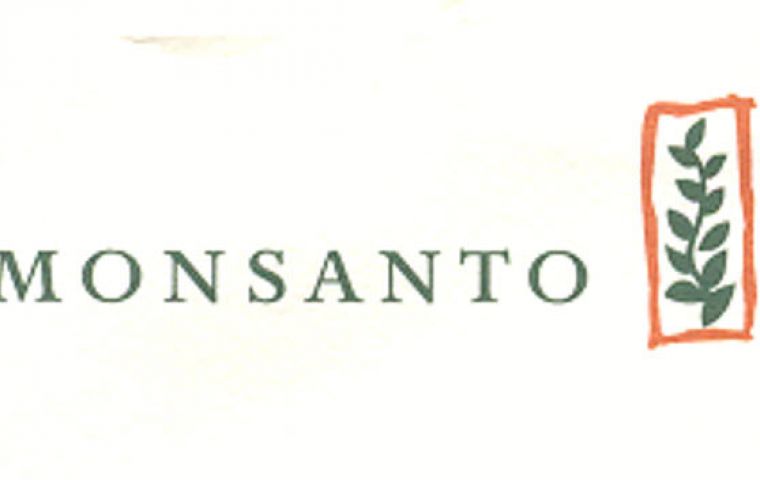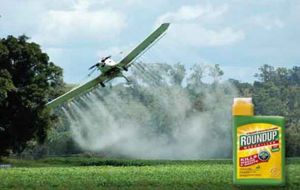MercoPress. South Atlantic News Agency
Monsanto and its glyphosate weed-killer embroiled in controversy in Argentina
 Monsanto says glyphosate which is extensively used in Argentina ”does not cause cancer in humans” according to the US EPA
Monsanto says glyphosate which is extensively used in Argentina ”does not cause cancer in humans” according to the US EPA  Argentina's harvest has tripled in the last 20 years, and in the same period, the agrochemical application per produced ton grew from 2.85 to 3.2 liters
Argentina's harvest has tripled in the last 20 years, and in the same period, the agrochemical application per produced ton grew from 2.85 to 3.2 liters Monsanto Co. is calling for more controls on agrochemicals, including its Roundup line of glyphosate-based weed-killers, in response to an Associated Press report about concerns that illegal pesticide applications are harming human health in Argentina.
“If pesticides are being misused in Argentina, then it is in everyone’s best interests - the public, the government, farmers, industry, and Monsanto - that the misuse be stopped,” the St. Louis, Missouri-based company said after the AP report was published Monday.
The company criticized the AP report as lacking in specifics about health impacts, though the story cited hospital birth records, court records, peer-reviewed studies, continuing epidemiological surveys, pesticide industry and government data, and a comprehensive audit of agrochemical use in 2008-11 prepared by Argentina’s bipartisan Auditor General’s Office.
Asked for Monsanto’s position on this, Monsanto spokesman Thomas Helscher told the AP in an email Tuesday that “the absence of reliable data makes it very difficult to establish trends in disease incidence and even more difficult to establish causal relationships. To our knowledge there are no established causal relationships.”
Earlier, Monsanto criticized the AP report as “overbroad in indicting all ‘pesticides’ when we know that glyphosate is safe.”
‘The U.S. EPA and other agencies not only say there is no evidence of carcinogenicity but go further to give it the highest rating, “E,” which means there is affirmative evidence that glyphosate does not cause cancer in humans.”
Argentine doctors interviewed by the AP said their caseloads _ not laboratory experiments _ show an apparent correlation between the arrival of intensive industrial agriculture and rising rates of cancer and birth defects in rural communities, and they’re calling for broader, longer-term studies to rule out agrochemical exposure as a cause of these and other illnesses.
“The story is overbroad in indicting all ‘pesticides’ when we know that glyphosate is safe,” Monsanto countered. ‘The U.S. EPA and other agencies not only say there is no evidence of carcinogenicity but go further to give it the highest rating, ‘E,’ which means there is affirmative evidence that glyphosate does not cause cancer in humans.”
This claim of safety, however, is a problem, Monsanto’s critics say. While glyphosate is less toxic in terms of acute exposure than many other herbicides, insecticides and fungicides, it is routinely blended with other chemicals when applied to crops. The spray that drifts from fields and seeps into groundwater adds to an overall chemical burden, a mix of many individual ingredients.
In 1996, Monsanto paid a 50,000 dollars fine and agreed to “cease and desist” promoting glyphosate as “safe” after New York’s attorney general sued it for false advertising.
Monsanto acknowledged then that EPA approval “is not an assurance or finding of safety” because U.S. regulations are based on a cost-benefit analysis, which balances the potential of “any unreasonable risk to man or the environment” against the “the economic, social, and environmental costs and benefits of the use of any pesticide.”
Argentine federal law follows a different standard. It says that when “faced with the possibility of serious and irreversible harm,” the users of a chemical must make sure they protect human health and the environment, even when there’s “a lack of information or scientific certainty,” and “no matter the costs and consequences.”
Asked which standard Monsanto should follow in Argentina, the company spokesman said it follows all applicable regulations all over the world.
“It is not for Monsanto to decide or give opinion about the legal principles that rule the regulations of the country. Monsanto is respectful of the Argentine legal and regulatory framework, and will comply with the principles Argentine authorities decide,” Helscher wrote Friday in response to questions from the AP.
Dr. Damian Verzenassi runs a continuing epidemiological study at the National University of Rosario Medical School that has found a 90% increase in cancer rates since 1997.
“They said this new system of production would diminish agrochemical use in the country. They called the arrival of GMOs a second green revolution,” he said Tuesday.
Helscher acknowledged to the AP on Friday that agrochemical use is growing, not decreasing, beyond what would be required by the dramatic expansion of farming in Argentina.
The country’s “agricultural production has tripled in the last 20 years, going from around 35 to just about 100 million tons that are currently produced. In the same period, the agrochemical application per produced ton grew at a dramatically lower pace of 2.85 to 3.2 liters according to the figures of the agrochemical industry,” Helscher wrote.
The AP report cited data from CASAFE, Argentina’s pesticide industry chamber, showing a nine fold increase in the overall amount of formulated agrochemicals sold annually, from 34 million liters in 1990 to more than 317 million liters in 2012.
After declining at first use, agrochemical use jumped by the time 100% of Argentina’s soy came from genetically modified plants and farmers stopped tilling the soil to kill weeds. As resistant pests exploded, farmers found themselves with little choice but to mix in much more toxic chemicals.
“It’s an integral chemical compound _ it has glyphosate, it has surfactant (to facilitate its dispersion), and on top of that they blend in 2,4,D (a hormonal weed-killer), endosulfan (an insecticide) and other agrotoxins,” Verzenassi said.
Helscher told the AP that “scientists do see a tendency for higher probability for resistance to evolve in these situations especially when there is sole reliance on a single herbicide for the management of the key weed species.” The answer, he said, is using “the appropriate combination of multiple herbicides.”
Monsanto said it would keep urging farmers to follow the rules. That hasn’t happened in Argentina, where no one was punished for violating federal spraying rules from 2008 to 2011, the auditor general found.
“We deplore the misuse of any pesticides, regardless of who makes them. Monsanto’s employees work very hard to ensure that our customers and suppliers are properly trained and use the products according to label instructions, and that applies to Argentina, the United States, and everywhere else we do business,” the company said.




Top Comments
Disclaimer & comment rules-

-

-

Read all comments“EPA approval “is not an assurance or finding of safety”” So from the other side of the coin, why then is EPA disapproval taken as evidence of harm?
Oct 24th, 2013 - 09:30 am 0I'm absolutely NOT surprised that there is a surge of adverse conditions in rural populations if the local farmers are mixing Roundup with additional surfactants, Endosulfan, 2.4.D, and other unspecified agrotoxins!
Oct 24th, 2013 - 12:54 pm 0It seems the culpability lays - in this case - with the Argentinian farmers and Argentinian health agencies.
Endosulphan and 2.4.D (a member of the DDT family) used on their own are serious human health risks.
Unspecified agrotoxins represent a further unknown category of risk to human health.
The whole lot, mixed together, creates a synergistic 'flare' - a risk where the toxicity of the whole is greater than the toxicity of the parts applied separately.
The contamination of watercourses and groundwater confers contaminations to drinking water in the home, and the specific risk to pregnant mothers in the early stages of pregnancy.
We took into my Biosciences department some years back an Argentinian researcher who specifically investigated the teratogenic (malformed babies) behaviour of these mixed agrotoxins.
The risks are known and understood in Argentina -
all undergraduate agro-scientists study this at some time in their courses.
The allowing of such practices to develop and proliferate makes the Argentinian government absolutely culpable - and liable to huge compensations.
Because: http://www.boston.com/bigpicture/2013/10/agrochemical_spraying_in_argen.html
Oct 24th, 2013 - 01:53 pm 0Commenting for this story is now closed.
If you have a Facebook account, become a fan and comment on our Facebook Page!